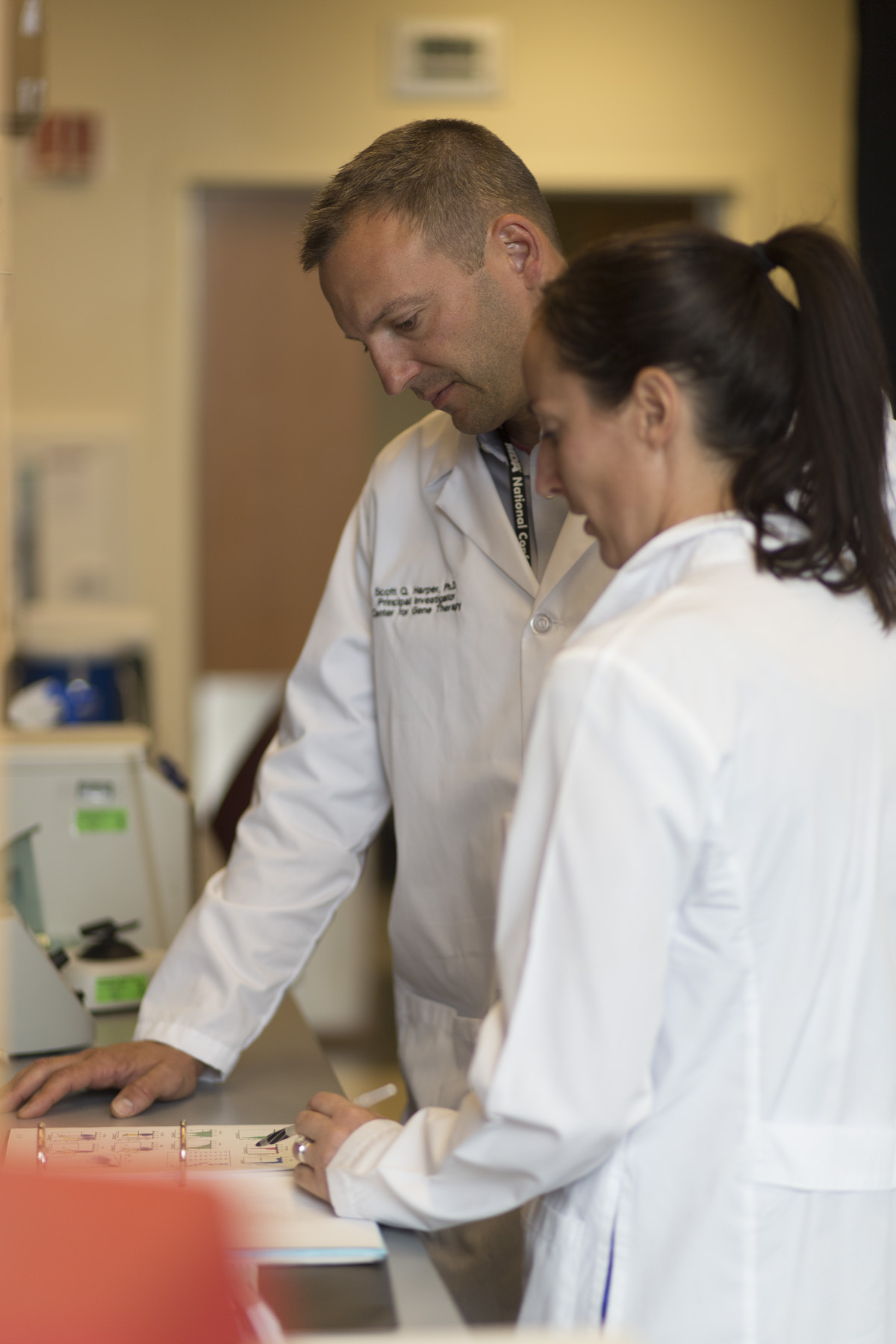Scientist Makes Journey Back to Pioneering Gene Therapy for CMT
Scott Harper, PhD, returns to CMT research 15 years after starting his own lab

Scott Harper, PhD, confers with Lindsay Wallace, PhD. (Courtesy of Scott Harper)
A chance meeting at a conference four years ago led two researchers to join forces and resulted in a CMT1A gene therapy now under development.
The 2018 Charcot-Marie-Tooth Association scientific conference was where Scott Harper, PhD, from Nationwide Children’s Hospital in Ohio, met Kleopas A. Kleopa, MD, PhD, a researcher from the Cyprus Institute of Neurology and Genetics.
Though it was never expected or planned, the meeting (and subsequent partnership) has led to a CMT1A gene therapy that’s now licensed by Armatus Bio and is making its way through the development pipeline.
“We were discussing both of our interest in trying to develop a CMT1A gene therapy, and kind of … went from there,” Harper said in a phone interview with Charcot-Marie-Tooth News. “And that collaboration is still going.”

Scott Harper, PhD, has been with Nationwide Children’s Hospital for more than 15 years. (Courtesy of Nationwide Children’s Hospital)
For Harper, 50, who has been investigating gene therapy since his PhD, being able to focus on CMT has been a part of a long journey. Since starting his own lab in 2007, he’s wanted to find a treatment for CMT, but the funding had never lined up. Now, with more resources available and new collaborations with other CMT researchers such as Kleopa, he’s full steam ahead.
Harper and Kleopa co-authored a paper in The Journal of Clinical Investigation this year describing the results of their CMT1A gene therapy in CMT mouse models. They found the treatment reduced disease-causing PMP22 proteins, improved motor performance in mice, and showed a reduction in CMT1A biomarkers.
The next step will be to conduct a successful animal study and submit an investigational new drug application to the U.S. Food and Drug Administration for permission to start a clinical trial.
Harper will be sure to mention this journey and collaboration with Kleopas at the upcoming CMT Research Foundation (CMTRF) convention Sept. 16–17 in Cambridge, Massachusetts. He is set to speak on day two of the conference on a panel focusing on biopharmaceutical activity in CMT.
More momentum in CMT research
Compared to when he first started his own CMT research, Harper has seen significant interest in the disease. There’s more momentum now than there was 10 or 15 years ago. That’s because of innovations in technology and new evidence that’s shown the success of therapies in the lab, he said.
CMT-related genes have been discovered showing additional pathways for new treatment research and development. Plus, scientists such as Kleopa have found better delivery systems for gene therapies. These adeno-associated viruses (AAVs) are designed to hit the peripheral nervous system’s Schwann cells more effectively than earlier versions.
Harper said CMT may be a rare disease but it still affects thousands in the U.S. and millions worldwide. That’s part of what drew him to the disorder — and CMT1A — in the first place.
“It’s a dominant disease. And we have the know-how and the technology to treat it with gene therapy, number one,” Harper said. “Number two: CMT1A is very prevalent, there’s a lot of people affected by it. So anything that we developed could actually potentially benefit a lot of people.”
Gene therapy’s an expensive proposition
The CMTRF has partnered with Harper’s research project that he kicked off at a similar conference a handful of years ago. The nonprofit announced in 2019 that it was funding the research partnership between Harper and Kleopa, and extended the funding for their project in February 2021.
“They’ve helped us by giving us funds and advising us. They’ve helped us launch some of these new ideas, and it’s really been invaluable,” Harper said. “Had we not had their support, we wouldn’t have the data we have. We probably wouldn’t have a partnership with Armatus on this project.”
To create the gene therapy, the researchers put together components of the AAV, the genes required to produce that virus, and the therapeutic gene in a human cell line that acts as a factory. Those cells are then destroyed and the AAV type 9 (AAV9) is purified from the cultured cell line. Dedicated manufacturing facilities are needed as trillions of cells are required to make enough of the gene therapy.
The CMT1A gene therapy also needs to be tested in a larger animal model to ensure it’s safe for humans. Usually, testing is done in monkeys or pigs, and those studies can cost millions.
Early funding from organizations such as the CMTRF is thus essential for research, Harper said. He and his team must get to a point where larger companies buy in and can commit the millions needed to go from “bench to bedside.” Someone has to see the future benefit of the treatment before a pharmaceutical company takes notice.
“We invested in this project because we understand the life-changing impact that an effective gene therapy for CMT will have,” Keith Fargo, PhD, chief scientific officer for CMTRF, said. “When the world’s first gene therapy for any disease was approved five years ago, the patients and families who founded the CMT Research Foundation stood up and took notice. In fact, this was the second project we ever funded.”
Interest in scientific research started early
Harper has had an interest in muscle conditions such as CMT for nearly as long as he can remember.
He recalls watching the Jerry Lewis Muscular Dystrophy Association (MDA) Telethon when he was younger. His father would be glued to the TV for as long as he could during the two-day event. Back then, only three channels were available and the Labor Day special was something his family would not miss.
Fast-forward to his postgraduate career at the University of Michigan, Harper wanted to work on research that could be of practical help to patients in the future.
“There was a lot of basic science stuff going on there,” Harper said. “And I really wanted to work on something more applied. Now we call that translational research, but that term didn’t exist back then.”
It’s there that he met Jeff Chamberlain, PhD, who was then working on a novel approach to treat Duchenne muscular dystrophy (DMD). Between 1996 and 2002, Harper developed an early method to deliver the micro-dystrophin gene to cells via an AAV9 virus. That technology is being used in Sarepta Therapeutics’ gene therapy trials for DMD, Harper said.
When he began his postdoctoral work at The University of Iowa, Harper shifted his focus to newly discovered RNA interference (RNAi), which can knock down the activity of genes rather than replace them. The two professors who discovered the technology won the Nobel Prize in Physiology or Medicine in 2006.
At Iowa, Harper worked in the Davidson lab, run by Beverly Davidson, PhD, to apply RNAi to neurodegenerative conditions including Huntington’s disease and spinocerebellar ataxia type 1. However, once he became a principal investigator and ran his own lab in 2007, Harper delved back into diseases affecting muscles.
Facioscapulohumeral muscular dystrophy (FSHD) and CMT1A were both relatively common diseases that could benefit from RNAi or gene silencing. In CMT1A, the duplication of the PMP22 gene leads to the overproduction of the PMP22 protein, which disrupts the structure and function of myelin — the insulating layer that protects nerve fibers and facilitates neuronal communication.
Grant reviewers saw promise in Harper’s CMT1A gene silencing approach but had questions about how practical it was, so his small lab had to accept the MDA grant for FSHD.
That wasn’t the end of Harper’s journey with CMT though.
“I always had this thing in the back of my mind where once I get more established and have more money and a bigger lab, I wanted to get back into the CMT world,” Harper said.
His first foray into CMT came 10 years after he had established his lab. Harper worked with Rob Burgess, PhD, from The Jackson Laboratory to try to silence the gene responsible for CMT2D. The two published a paper in 2019, also in The Journal of Clinical Investigation.
That led to an invitation that landed him at the conference in 2018, which would eventually connect him with Kleopa, a scientist who had a similar interest in gene therapy research for CMT.
Now he’s being invited to speak on a different stage — the upcoming CMTRF Global Research Convention. The experience could yield another chance meeting leading to another successful partnership.
In the last couple of years, Harper has found the CMT community has been more than welcoming.
“I just found the whole community, at every level, the scientists, and the foundations, to be just amazing people and very collaborative,” Harper said. “It’s been a really great community. I’m super happy that I was able to join this field.”








